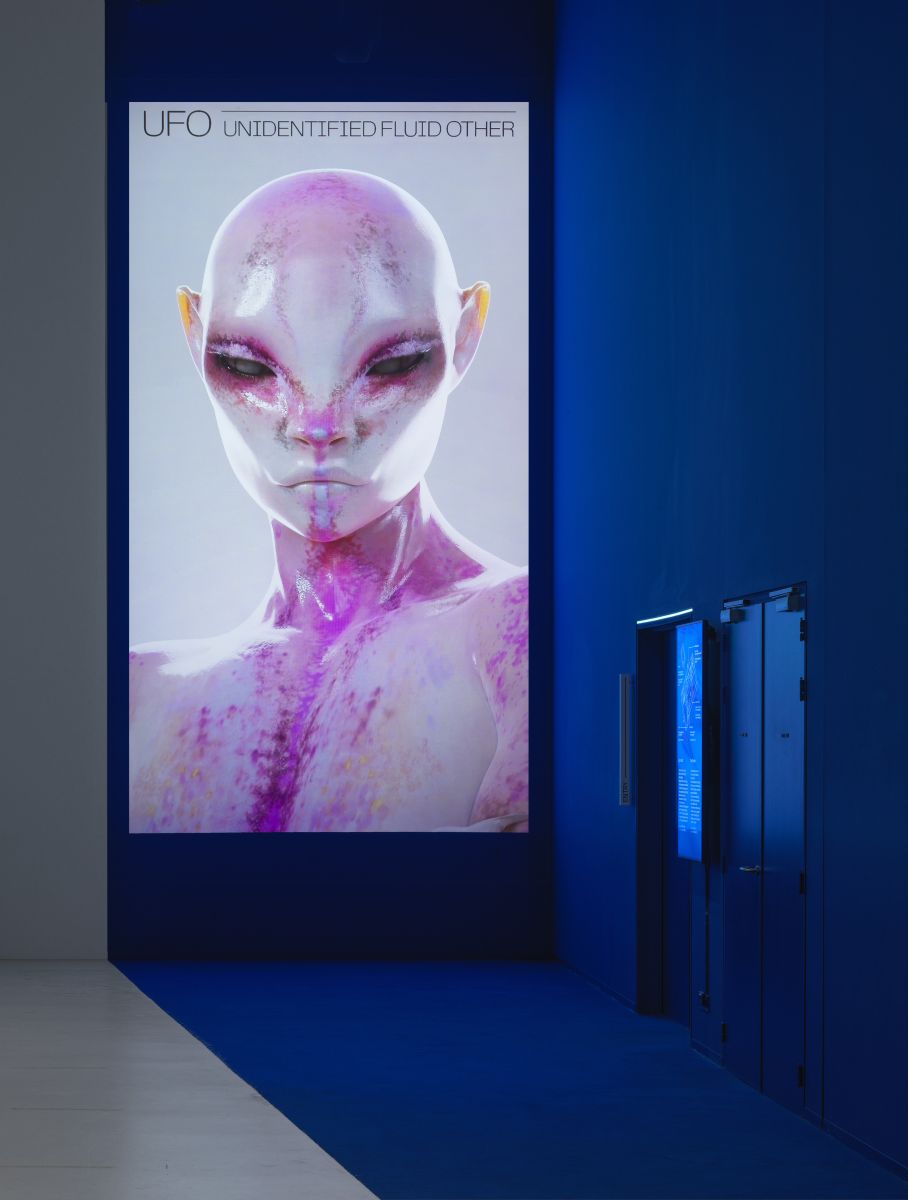Text by Katažyna Jankovska
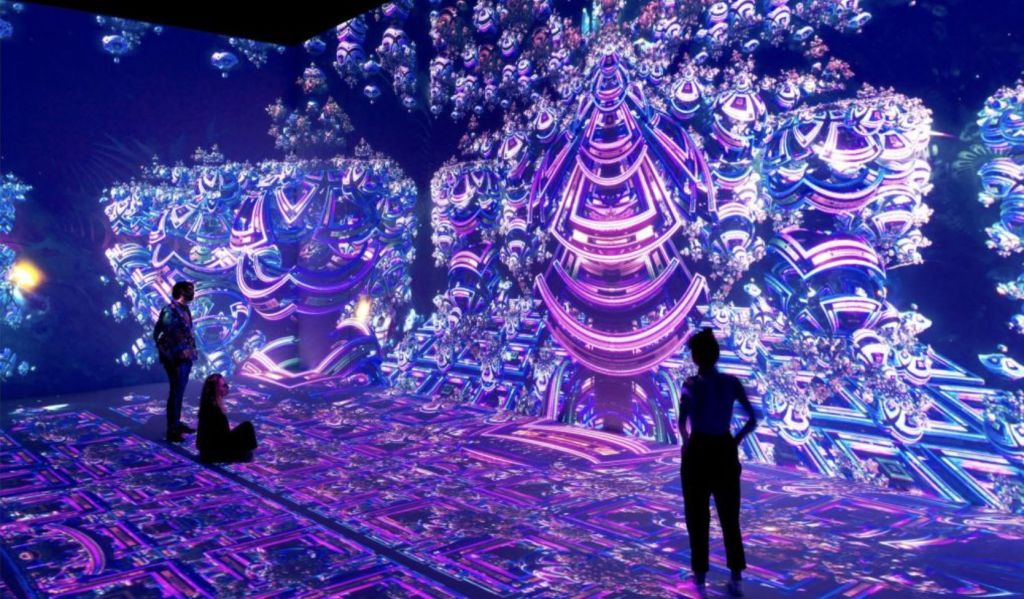
As individuals shift from one state to another, they undergo a rite of passage. Performed in the moments of transition, the rite adds to the construction of new norms and systems of behaviours. Today’s rites of passage take an altered form; supported by pervading technologies, robotics, and virtual reality, they are of particular importance to creating new social frames, demarcating the transition of a given society. Stefania Operto calls them “technology-assisted rites” [1].
Drawing parallels between rituals and technologies, the exhibition Unidentified Fluid Others curated by Bogomir Doringer at Nxt Museum in Amsterdam illustrates the ongoing social transition from physical to virtual, elevating humans to a post-binary dimension. While reconstructing traditional folklore and notions of identity, selected artworks seem to reflect on how we present ourselves, whom we idolize, and what we celebrate.
Before entering the exhibition, a genderless shiny creature appears on the screen. A part of Harriet Davey‘s 3D work Viatrix’s Oddysey, this god-like figure looks at us from above, representing new beliefs and diminishing the social significance of gendered embodiment. Becoming a symbolic medium found in most cultures, their image simultaneously subverts ideas of the artistic nude and the history of body representations, creating new iconography reflecting today’s society. They lead us throughout the exhibition, which itself operates as a rite of passage of sorts, aligning their transformation alongside our own.
In The Rites of Passage, anthropologist Arnold van Gennep distinguishes three phases of the rite – separation, transition, and reincorporation. The first stage, also called a pre-liminal rite, comprises breaking from previous social structures and fixed routines. It is a separation moment in which the individual is detached from normative practice, lifting away existing structures. While corporately entering the exhibition space, we perform a separation rite through the interactive light installation ENTER by Ksawery Kirklewski, which operates as a liminal portal dislocating us to the world of the virtual. Sanctioning the passage into another state, this initiation rite separates our physical and virtual bodies, sending our scanned image to the world we are about to enter.
After passing the gateway, we found ourselves in between two worlds, halfway between the real and the virtual. This threshold, otherwise called liminality, refers to the transition between two structured states, where society abandons deep-seated beliefs and is being restructured in a new direction. Spatiotemporally dislocated into the metaverse yet still physically navigating the exhibition; we are waving between old and new worlds.
Here we are entering not only the realm of rituals but that of religion too. Liminal thinking finds its roots in Buddhism – the intermediate state of Bardo is the transitional state between two lives, the one between death and rebirth. This passage from one existence to the next in which consciousness is not constrained by the physical body appears in the video work and video game Great Adventure of the Material World by Lu Yang.
Combining anime with Buddhist ideas, Yang goes beyond the limits of the material body, exploring streams of consciousness. We are navigating the post-death virtual realm through the eyes of the non-binary Material World Knight, who makes their way from the afterlife into the material world. Digitally reincarnated, the androgynous character developed by Lu Yang enters the realms of hell and paradise, wandering between eternity and their existence.
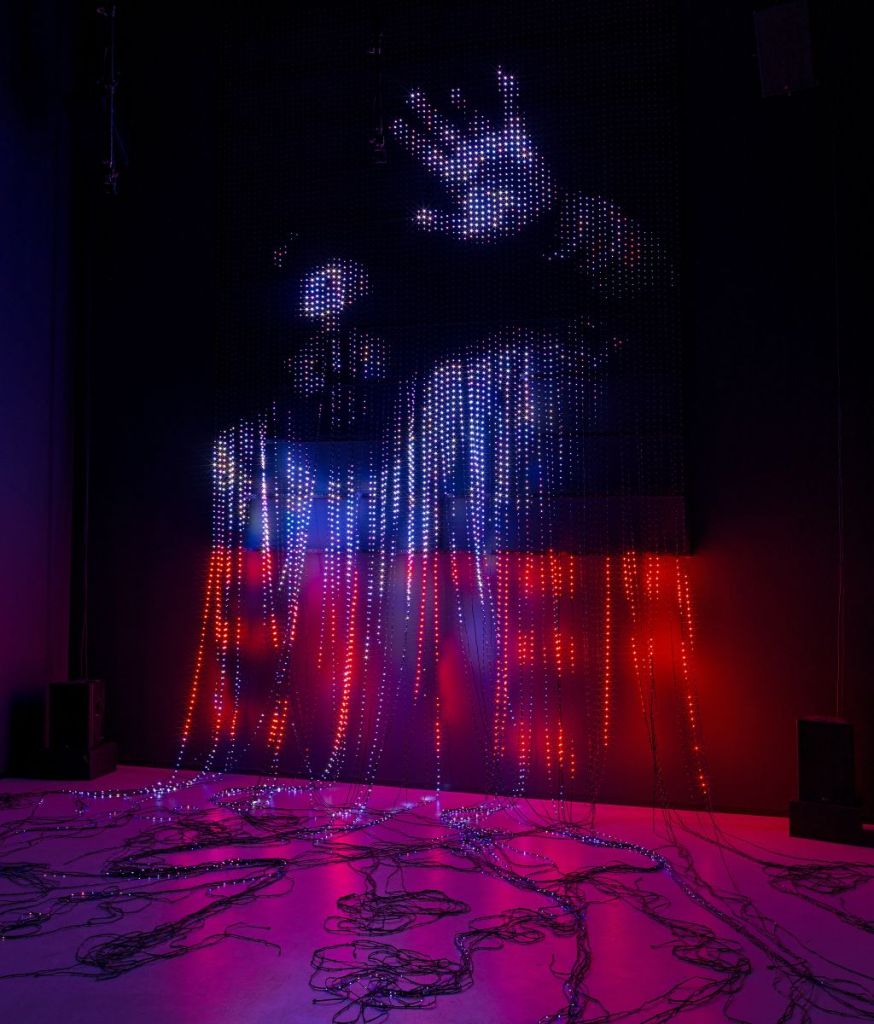
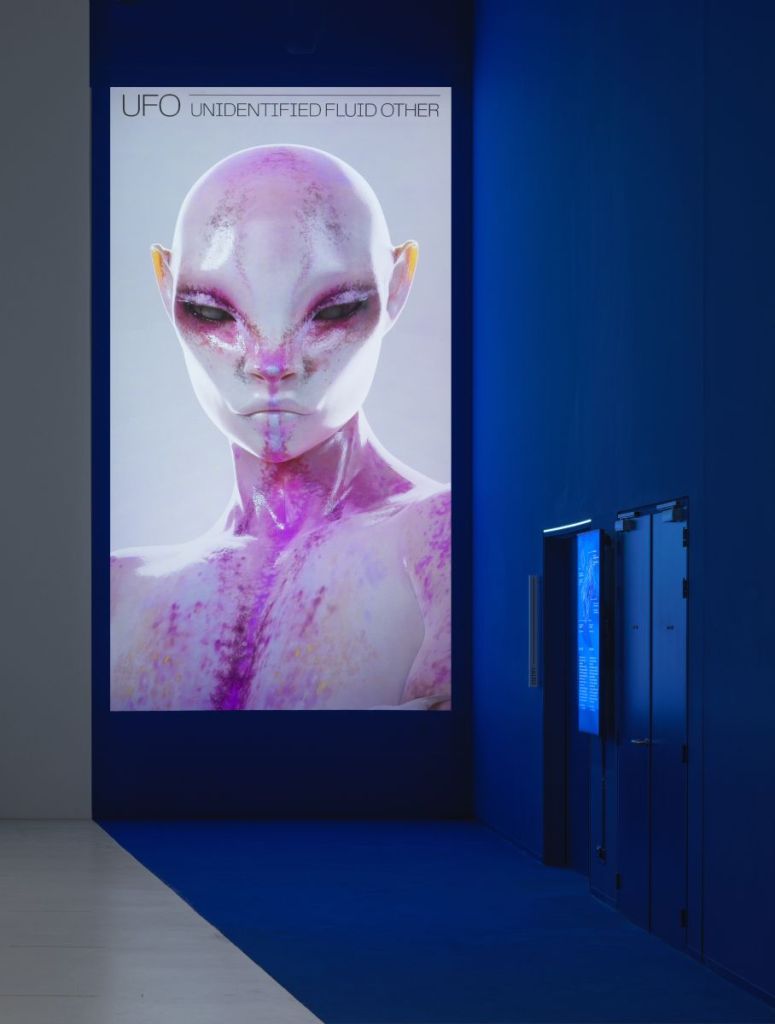
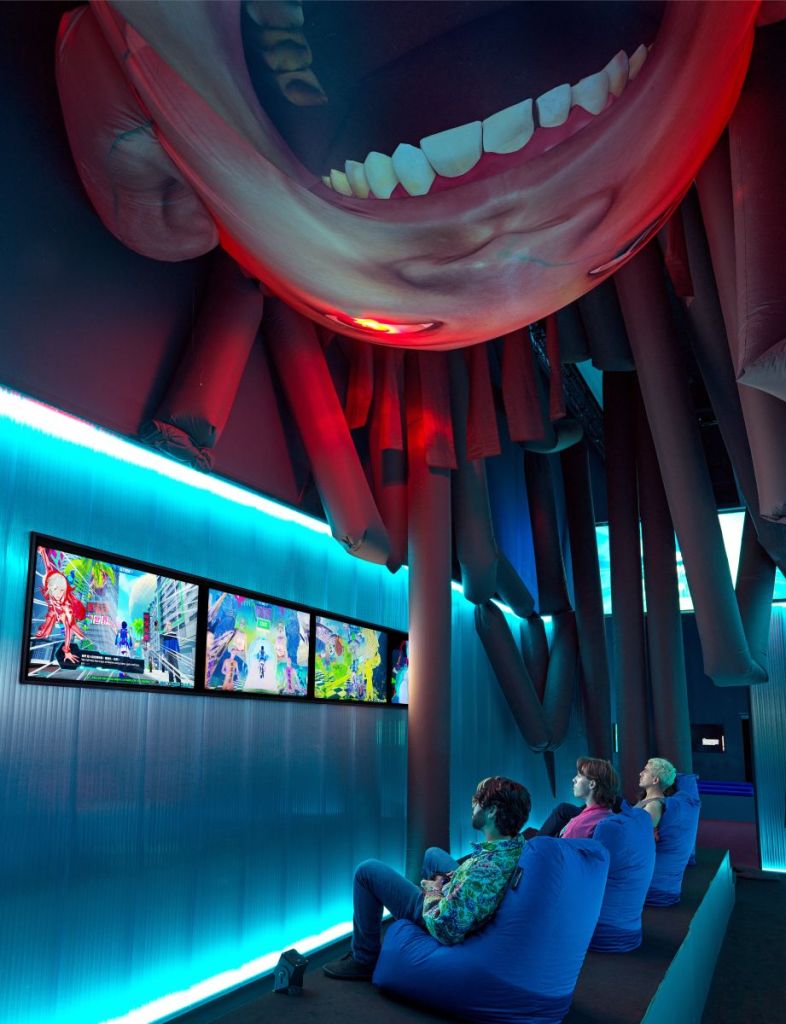
The infinite liminal space can also be challenging; it contains a lot of doubt and uncertainty. Liberating possibilities in the liminal can prolong the transition moment to a state of being and evoke a sense of disorientation. Anthropologist Gregory Bateson defined schizophrenia as an inability to set a frame; if the ambiguity isn’t moulded within the new frame, we are confronting ceaseless liminality.
Jacolby Satterwhite frames the prevailing uncertainty into multilayered digital renderings of queer landscapes. Satterwhite’s video installation Birds in Paradise emerges from his mother’s drawings influenced by progressing schizophrenia. Translated into neon-hued digital landscapes, they take the form of the phantasmagoric coliseum, inhabited by ritualistically moving bodies.
The 360-degree viewing experience of repetitive choreographies of tangled bodies within a coliseum is paired with footage of him being hung upside down and shrowded, recalling both West African shrouding rituals related to rebirth and regeneration, and the ritual of baptism.
Playing with visual history and challenging the art canon, Satterwhite connects ancestral and queer mythologies, Western and African folklores. Through the mode of repetition and circularity, the artist stands in the limen, becoming a mediator between two worlds.
The correlation between rites and repetition suggests taking the algorithmic perspective on rituals. The algorithm -an abstracted element nowadays associated with digital computers- has been used as an analytical tool since ancient times. Algorithms are sets of instructions, rules, techniques, and repetition.
They can be understood as codified rituals that emerge from a system of (symbolic) actions and repetition to achieve the desired outcome. Algorithms and rituals seem to operate according to a similar logic, both stemming from material reality. In Foreign Nature, Julius Horthuis renders architectural forms that morph into kaleidoscopic, hypnotically mutating space.
Computer-generated fractals result from translating fundamental mathematical patterns that govern our lives. Artificial intelligence thus is a continuation of ancient techniques of knowledge, or as Matteo Pasquinelli frames it, “an enormous imitation engine of collective intelligence”[2].
Horthuis’ hypnotic renderings mimicking psychedelic imagery at the same time recall the idea of pre-internet virtual worlds. People found ways to enter virtual worlds beyond what material bodies could reach; dreams, psychedelics, and rituals opened up the realm of the virtual. Now when this realm is brought to the material reality, as Margaret Wertheim asks, where could a spiritual realm possibly be?[3]
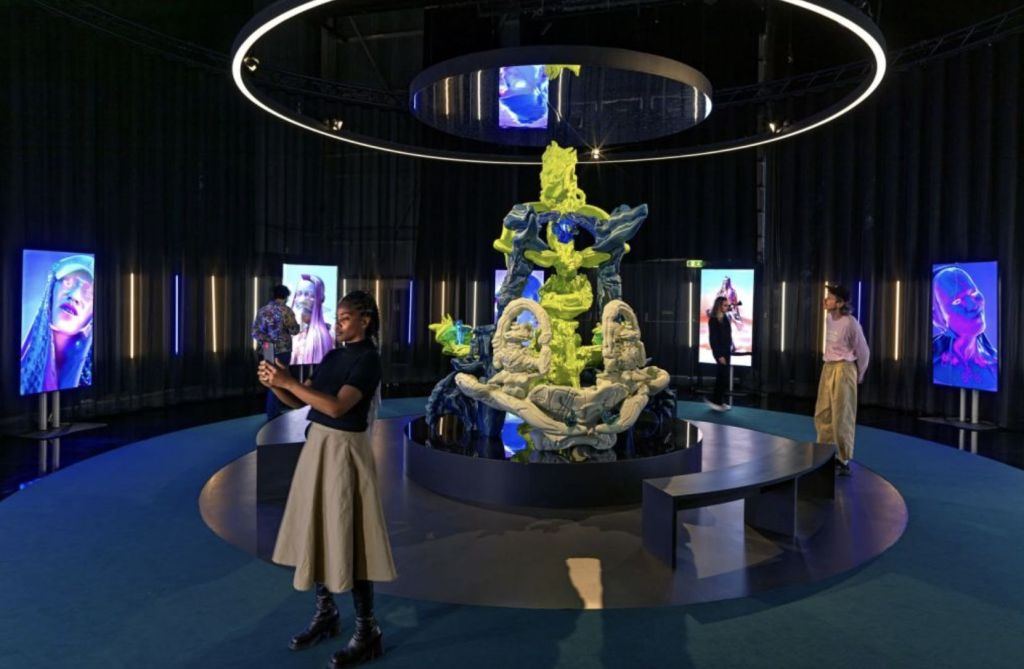
Rituals usually are performed around objects, using garments integral to the cultures, yet in liminality, no recognizable physical attributes refer to the previous or future worlds. Such liminal object, an artefact that belongs to both realms, is a work by Audrey Large, The Waters in Between.
Born in the digital environment, 3D printed object enters the physical reality before the moment of recognition. Stuck in between two worlds, a new archetypal object appears in the shape of a seamless shiny totem, an altar to yet unknown god. Liquid-looking polylactic acid sculpture questions not only the materiality of our bodies but also our perception of materiality in a broader sense.
Further leaving behind the recognizable objects and unfolding the potential of the space in between, digital fashion house The Fabricant displays renderings of clothing and masks in their project Whole Land. Originating from video games and rituals of masking, the possibility of customizing and updating avatars with garments and accessories now expands beyond the gaming environment.
Digital garments that make gender irrelevant add up to the processes of identity construction and allow one to re-make oneself. Although digital fashion is never physical, the possibility to adorn one’s physical body with digital outfits through the screen brings back the liminal moment, reflecting on corporeal malleability and subverts categories of sex, gender, and race.
The final stage of the rite of passage and transition process – the incorporation – endows the community with a new identity. A post-liminal phase is characterized by incorporation into the new social structures and behaviours. Although there are no clear boundaries of this phase, it brings acts of celebration, usually a dance, that marks one’s re-entry into society.
The last work of the show Nu radio World Tour by Oseanworld, a work commissioned by the Nxt Museum, could be seen as a new form of collective rite of contemporary society. Despite being a total sensory overload, it brings people together for collective activity, interacting with the new world inhabited by creatures from artists’ dreams.
Nevertheless, this collective celebration rite doesn’t mark the end of the transition. Instead, the works in this show operate as an example of the generative powers of liminality. Derived from personal mythologies, dreams, and mental states, the stories are fabricated to be universal.
They generate new collective legends and reconceptualize symbols that define our behaviours. And although the exhibition incorporates new, already visible categories and customs, our society is still filled with ambiguity, wandering within the liminal. While technology enables recrafting of our bodies and the reconstruction of identities along the axis of gender and race, it at the same time contributes to the digital divide and exclusion. Technological progress and access to advanced technologies are not equally allocated; hence technology-assisted rites are within reach of those who possess technological devices.
As Stefania Operto notes, technologies are not necessarily the factor that regulates the rite, but they, of course, add to the circulation and distribution rituals. Those, in turn, are relocated and performed in the private sphere yet visible in public. The importance of technology-assisted rites, therefore, is that they don’t need to be recognized by the authority[4]. They are started from the bottom up, enacted, and celebrated by communities that accept them.

